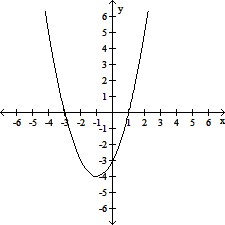For the given functions f and g, find the requested composite function.f(x) =  , g(x) =
, g(x) =  ;
; Find (f ? g)(x).
Find (f ? g)(x).
A. 
B. 
C. 
D. 
Answer: C
You might also like to view...
Solve using Cramer's Rule.The perimeter of a rectangle is 19 meters. If the width is doubled and the length is tripled, the perimeter is 50 meters. Determine the original width and length.
A. width = 6 m, length = 10 m B. width = 8 m, length = 17 m C. width = 7 m, length = 12 m D. width = 3.5 m, length = 6 m
Solve the equation using a graphing calculator. Round the answer to two decimal places.-4x2 + 4x + 5 = 0
A. {-0.72, 1.72} B. {-11.5, 12.5} C. {-1.45, 3.45} D. {-1.72, 0.72}
Find the domain and range of the function represented in the graph.
A. Domain: (-?, ?); Range: (-?, ?) B. Domain: (-?, ?); Range: [-4, ?) C. Domain: [-1, ?); Range: [-4, ?) D. Domain: (-?, -1) or (-1, ?); Range: (-?, -4) or (-4, ?)
Use the Factor Theorem to determine whether x - c is a factor of the given function for the given value of c. If x - c is a factor, then write f in factored form. That is, write f(x) = (x - c)(quotient).f(x) = 7x3 + 30x2 + 17x + 36; c = -4
A. Yes; f(x) = (x + 4)(7x2 + x + 9) B. Yes; f(x) = (x + 4)(7x2 + 2x + 9) C. Yes; f(x) = (x - 4)(7x2 + 2x - 9) D. No